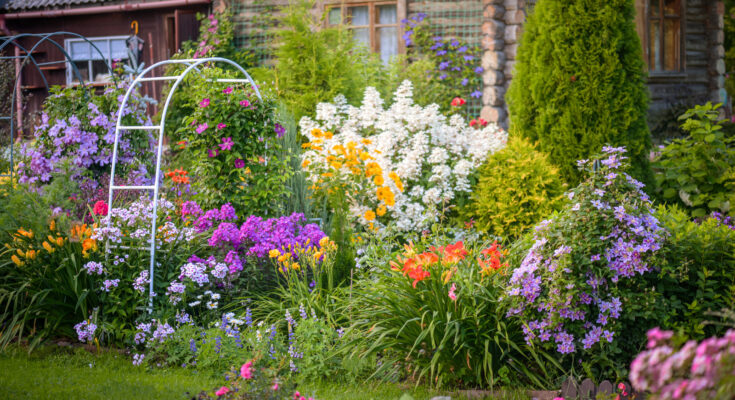26 Summer Blooming Perennials Perfect For A Colorful Garden
It can be disheartening when, after an explosive bout of gorgeous blooms throughout spring, your garden display just fizzles out. While it’s easy to rationalize that not all plants can weather the heat creeping in, the thing is that there’s a wide array of summer-blooming perennials that you can utilize to create a vibrant landscape. Better still, you can depend on them to maintain the display year after year — even for short-lived perennials – if you can manage to pinch off their seedheads right after flowering to help them put their energy toward next year’s blooms.
But before you rush to the nearest nursery, take a few notes. Typically, perennials don’t have a long blooming period, even though options like threadleaf coreopsis and blanket flowers certainly do. For this reason, it’s ideal to plant multiple species successively to ensure your garden remains the show-stopper, no matter how high the mercury soars or what month it is. For instance, clustered bellflowers and Siberian irises will bloom with aplomb in early summer, while coneflowers, gaura, daylilies, and hibiscus will be more dependable during the hottest months. Asters and Agastache might see you through until the fall-blooming plants kick into action. Get the drift? Here’s a quick roundup of 26 summer-blooming perennials perfect for a colorful garden.
Matrona stonecrop
If you maintain a rock or water-wise landscape in zones 3 to 9, ‘Matrona’ stonecrop (Hylotelephium ‘Matrona’) is worth a spot, either as a specimen or planted en masse. Its purple-veined, fleshy leaves conserve water, enabling the perennial to survive arid or drought conditions. Assuming a vasiform appearance, ‘Matrona’ breaks out huge heads of pastel-pink petals early in the summer, with the display lasting until after frost. Ensure the plants are sited in full sun and well-draining soils, or they’ll flop down. Also, pinch their tops to promote bushier growth. You’ll have to watch for slimy pests.
Clustered bellflower
Are you seeking early summer blooms for moderately shaded, moist soils? Try out clustered bellflowers (Campanula glomerata). Growing wider than tall, clustered bellflowers become jam-packed with blue-purple blooms when spring transitions to summer, attracting many pollinators, including hummingbirds, native bees, and butterflies. Grow these herbaceous perennials in borders to coax deer and rabbits into moving elsewhere. They’re cold hardy in zones 3 through 8 but require full sun exposure in colder climates. Sandy or alkaline soils pose no problems.
Siberian iris
Banking upon their love for moisture, you may use Siberian irises (Iris sibirica) as low-maintenance plants that will flood your rain garden with an abundance of vibrant, velvety blooms in early summer. These irises are hardy in zones 3 through 8, and although they look their best in full sun, they fare better with some afternoon shade in hot southeastern U.S. states. They might not be the favorite of deer (thankfully!), but are amply popular with nectar-sipping hummers, as well as native bees, which use their stems for overwintering habitat. These irises can cause contact dermatitis and are poisonous on ingestion, so site them carefully.
‘Steffi Dark Rose’ gaura
Well-adapted in zones 5 through 9, ‘Steffi Dark Rose,’ a cultivar of Gaura lindheimeri, is an excellent drought- and heat-tolerant addition to perennial gardens. During the spring-summer transition, you’ll find wispy, pink-blushed flowers supported over dainty stems, floating above red-speckled foliage, sometimes as late as fall. However, make sure to snip off dead flowers to make space for new blooms. These herbaceous perennials can grow about 2 feet tall and wide. Consider pairing them with bellflowers, irises, or phlox for a dramatic effect. Alternatively, mass them in borders as a deer deterrent.
Cherry sage
Popularly known as Autumn or Texas sage, cherry sage (Salvia greggii), is a stunning addition to sunny beds and borders when massed, especially in the southern regions. Hardy through zone 8, this flowering perennial reliably returns after winter, as long as you leave the area intact. Depending on the cultivar, expect red, coral, pink, or white tubular flowers to delight hummingbirds all summer, until the plants are frost-killed. Full sun is preferred, but in hot climates, protection from the afternoon sun is necessary. It also tolerates partial shade and rocky substrates, and usually remains pest-free.
Indian Summer Peruvian lily
A part of the Summer Paradise group, Indian Summer Peruvian lily (Alstroemeria ‘Tesronto Imp’) will magnify your summer garden’s brightness with its coppery-orange blooms above a sea of bronze-tinged, dark green leaves. The best part, though? You can expect them to bloom year-round in warm climates or late fall when it gets colder up to zone 8. Moist soils along with half-day sun, will deepen their colors. As Peruvian lilies grow quickly, you must feed them a liquid fertilizer for optimal growth. Deadhead for new blooms and don’t forget to divide these perennial plants in spring.
Fernleaf yarrow
Named so for the foliage that sports a fern-like texture, fernleaf yarrow (Achillea filipendulina) will swathe your garden with fragrant, yellow blooms throughout summer, if you keep deadheading it. Hardy in USDA zones 3 through 9, fernleaf yarrow exhibits resistance to heat, salt, and dry, poor soils, making it suitable in diverse conditions. However, they require a minimum of six hours of sun exposure. Plonk yarrows in pollinator gardens for butterflies or borders as a deer-deterrent. They may also be used in cut gardens — their flowers will last long in floral arrangements. Separate their clumps regularly for size containment.
Giant hyssop ‘Acapulco Orange’
Giant hyssop ‘Acapulco Orange’ (Agastache ‘Acapulco Orange’) is one of the best plants to grow in shallow soil, given its proclivity to dry, sandy conditions. It abhors wet feet, so if you receive lots of rain, this perennial might not be for you, despite being cold hardy through zone 5. But if desired, you can plant it in raised beds. ‘Acapulco Orange’ is especially great for southeast summer heat. It has a tidy habit, growing about 1 foot up and across. Orange flowers bloom atop minty foliage from summer through frost, enchanting hummingbirds and butterflies.
Plains zinnia
When you have sand or gravel for soils, consider planting prairie or plains zinnia (Zinnia grandiflora), which has adapted well to such conditions due to its origins in the southwestern U.S. It’ll be swathed in orange-eyed, yellow blooms from May to October, attracting myriad butterflies and bees. After blooming, it’ll sit tight as an 8-inch-high mat of needle-like green leaves. However, since its seeds are difficult to source, you may need to start with divisions. As plains zinnias send across runners, they’re great for stopping erosion in sloped garden beds. They’re well adapted to zones 4 through 8.
African mallow
If you’re looking to keep honey bees fed throughout the year, consider African mallow (Anisodontea capensis) — at least in the south, as its foliage dies back during winter in frost-prone regions, resprouting in spring. African mallows are easy to maintain, as they don’t really attract the attention of pests. Plus, their dead petals drop off on their own accord, doing away with the necessity for deadheading. They’re great for water-wise landscapes, considering their drought tolerance. Group them in foundation beds or informal hedges to bask in their clouds of pink or red blooms.
Señorita Rosalita spider flower
Not all cleome plants are annuals. Certain varieties like Señorita Rosalita spider flower (Cleome Señorita Rosalita ‘Inncleosr’) can also be grown as perennials, albeit in a limited range of zones 9 and 10. They have superior disease resistance and lack of thorns. Through summer and fall, enjoy hummingbirds and butterflies hovering around their pink-purple flowers. If deer are a problem, Señorita Rosalita can drive them out, keeping your border and foundation beds nice and healthy. Give them full sun for the best show. Regular watering during establishment is essential to benefit from drought tolerance on maturity.
Moonbeam threadleaf coreopsis
To edge flower borders, especially if they frequently experience deer pressure or receive salt runoff, consider growing ‘Moonbeam’ threadleaf coreopsis (Coreopsis verticillata ‘Moonbeam’). This herbaceous perennial will brighten your garden with lime-yellow, daisy-esque flowers, all summer long (sometimes even in the fall). Well-adapted for zones 3 through 9, ‘Moonbeam’ resists drought, lean soils, and humidity. Make sure to site the 1-foot-tall plant in full sun; it may take light shade in hot climates. Avoid fertilizing it or the foliage will develop an open habit. Self-sowing isn’t a problem, as the seeds are sterile, but watch for suckers.
Purple coneflower
Hailing from the east and central U.S., purple coneflower (Echinacea purpurea) can leave your summer garden awash in pink hues with butterflies. Leave some blooms be, and the perennials will self-seed. Plus, they’ll feed winter birds. Purple coneflower can hold its own against drought, heat, lean soils, and deer. Don’t forget to look through these stunning varieties of coneflower you could be growing in your garden before hitting your local nursery. If your area has a history of phytophthora, make sure to get disease-resistant cultivars. Full-to-part sun exposure in zones 3 through 8 works.
Blanket flower
Available in a variety of sunset hues, including red and orange, blanket flowers (Gaillardia spp.) will keep your gardens animated with bees and butterflies who enjoy their summer blooms. However, you’ll need to remove the spent blooms regularly to make space for new ones. Don’t forget to don gloves beforehand, as it can cause skin irritation. Eventually, the faded flowers will make way for fuzzy seeds, attracting goldfinches. Blanket flowers look spectacular fronting borders. Although short-lived, they self-seed, keeping the flower bonanza going year after year. Give them full sun exposure and good drainage in zones 3 through 9.
Daisy fleabane
Daisy fleabanes (Erigeron spp.) won’t grow aggressively in your garden since they’re hybrids. Native to the northwest U.S., daisy fleabanes will burst out yellow-eyed, pink, purple, or blue-threaded flowers throughout summer and intermittently in the autumn. Although hardy from zones 2 to 11, it’ll fare better with light shade in hot summer climates, as opposed to full sun requirements necessary otherwise. They’re unfussy about soils for the most part, though they dislike wet conditions, especially during winters. They’re reliable in drought-tolerant, rock, and pollinator gardens. You may also insert their seeds between pavers for color.
Colorado Gold gazania
To rouse a burst of gold color from your gravelly soils, grow ‘Colorado Gold’ gazania (Gazania linearis ‘Colorado Gold’) — it quite desires their quick-draining nature. Merely growing 4 inches tall, and twice as wide, it’s an excellent addition to small gardens. Aside from the saucer-shaped flowers that maintain interest throughout the summer and fall, their leaves add a pretty touch when they reveal their silvery undersides. Mass them in beds or borders in zones 5 through 9 for the highest impact, though they’ll look equally pretty in container gardens. Deadhead to encourage continuous blooming and prevent self-seeding.
Perennial sunflowers
Barring Helianthus annus, most sunflower varieties (Helianthus spp.) are perennials and given their diversity, it’s easy enough to find plants native to your area. Although their flower heads aren’t as huge as their annual counterparts because they sprout a greater number of flower stalks, they look just as spectacular in the summer. Standard specimens can grow over 6 feet tall. But if you would prefer something shorter, explore their compact hybrid cultivars like ‘Suncatcher’. Sunflowers require full sun exposure and are hardy through zones 6 through 9. You may have to monitor the plants for self-seeding.
Sandhills blazing star
Add vertical interest to your summer garden with pink-purple flowering spikes sprouting from sandhills blazing star (Liatris pilosa). Perennials in zones 6 through 9, sandhills blazing star require six hours of direct sunlight, or they’ll grow straggly. Acidic, sandy soils are the preferred medium, even if suffering from lean soils. Due to their drought and heat tolerance, they make great xeric plants. Plant them in drifts to attract a bevy of pollinators, or grow them as accents in borders. Although they can be started from seeds, corms are more suitable for quick establishment.
Daylilies
Although an individual daylily (Hemerocallis hybrida) flower doesn’t last beyond the day, these hybrid perennials maintain gorgeous interest throughout the summer when put together due to their profuse growth. Available in a broad spectrum of colors, shapes, and forms, you’re bound to find cultivars you can fall in love with. ‘Apricot Sparkles,’ ‘South Seas,’ and ‘Stella D’Oro’ promise second flushes. Daylilies bloom with little care, provided they receive full sun and good drainage. They aren’t popular with pests (thankfully!) and can be drought tolerant after establishment. They’re cold hardy through zone 3 and look best in mass plantings.
Halberd-leaved rose mallow
Native in and around central and east U.S., halberd-leaved rose mallow (Hibiscus laevis) is another herbaceous perennial you may consider growing in zones 4 through 9. It grows well in wet soils, receiving full sun or light shade exposure, making it suitable in coastal gardens or muddy areas enclosing water features (like ponds). As the plant can grow over 4 feet tall, it’s best sited at the back of borders. That way, you can watch hummingbirds and butterflies drinking their hearts out from the pink flowers that often remain in bloom from June to September.
Phlox ‘Wanda’
Although its origins are unclear, ‘Wanda’ is an unpatented phlox hybrid with a compact habit and big flowers. In zones 5 through 10, ‘Wanda’ supports a mass of fuchsia pink flowers from June onwards to October, inviting in butterflies. Group the low-growing perennials in borders or slopes for the highest impact. Deadhead the discolored flowers to encourage new blooms while limiting self-seeding. Despite their tolerance for light shade, it’s better to provide these phlox hybrids with full sun so they may remain steady on their feet.
‘Purple Potion’ agapanthus
Hardy through zone 7 and above, Monrovia’s ‘Purple Potion’ agapanthus (Agapanthus inapertus ‘HinGrkop’) is a superior agapanthus variety that fortunately doesn’t flop over when it reaches maturity. Either in the ground or pots, ‘Purple Potion’ will infuse the space with a formal look, so don’t shy from massing the perennials in border edges or along hardscaping elements. However, be warned that their stems can grow sparse eventually. These evergreen beauties require full sun exposure and well-draining soils. You’ll need to keep the plants watered in dry conditions as their drought tolerance is limited.
Asters
Aster is another perennial flower perfect for attracting pollinators with late-summer blooms that will see you through the fall. As they come in a wide variety of colors, including pink, lavender, blue, purple, and white, mass them together in beds to create a colorful spot. Alternatively, use them in your container gardens framing the walkway. Hardy in zones 4 through 8, asters tolerate full-to-part sun exposure and clay soils. However, they don’t bloom as profusely in dry conditions. Look for shorter varieties, or they might require stake support. You may need to thin the plants to encourage better blooms.
Iron Butterfly ironweed
For truly drought-resistant plants that will thrive without much water and would grow miserable if you give them a generous soak, plant Iron Butterfly ironweeds (Vernonia lettermannii ‘Iron Butterfly’). Compact at under 3 feet, this cultivar produces deep purple blooms, plentifully, in late summer, helping bees, butterflies, and moths prepare for the winter. To prevent the perennials from splaying out after flowering, ensure they’re planted in sunny, dry, and lean soil. Their fine-textured, thread-like foliage remains virtually disease-free in the Midwest, and they are hardy in zones 4 through 9.
‘Goldsturm’ black-eyed Susan
Blooming daisy-esque deep yellow flowers atop its 2-foot clump mid-summer through frost, ‘Goldsturm’ is an ornamentally superior cultivar of Sullivant’s coneflower (Rudbeckia fulgida var. sullivantii). It’s best planted in drifts receiving full sun exposure, albeit it may tolerate some shade. Keep removing spent flowers to encourage continual blooming and clip rhizomes unless you don’t mind the perennials colonizing. Although hardy in zones 3 to 9, you must monitor the foliage for spots and mildew in humid conditions. Better yet, cut back the plant in the fall and divide regularly to promote adequate air circulation.
‘Pink Pearl’ Agastache
Terra Nova Nurseries’ latest spin on hummingbird mint (Agastache) birthed ‘Pink Pearl,’ a gorgeous two-toned, pink-flowering hybrid cultivar that remains in bloom through frost. A full sun lover, ‘Pink Pearl’ requires excellent drainage and fertile soils for the best show. It’s hardy in zones 6 and south, and exhibits drought tolerance after it has gained its footing. Stick the over 1-foot-tall plant in flower borders to urge deer to feast elsewhere. Or, pop in container gardens where you’ve the best view of butterflies or hummingbirds hanging around the flowers.



